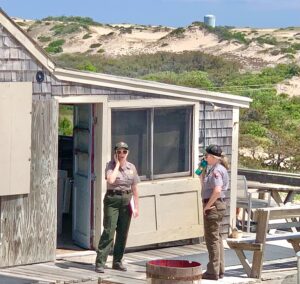PROVINCETOWN — At least 45 people were given tours last week by National Park Service officials who are running the current bidding contest for eight of the 18 dune shacks of the Peaked Hill Bars Historic District, on the back shore of Provincetown and Truro.

Prospective bidders were driven by park rangers from the Province Lands Visitor Center to the shacks — directly past a cluster of protesters who held signs and chanted slogans at the entrance to the dunes on Route 6.
The hand-painted signs read “Don’t Gentrify the Dune Shacks,” “No High Bid Leases,” and “Robbing Family Property,” with the letters RFP highlighted — a reference to the Park Service’s current Request For Proposals, which has been criticized by the select boards of Provincetown and Truro for not following the Park Service’s own Historic District Preservation and Use Plan from 2012.
In a letter to the Provincetown Select Board last week, National Seashore Supt. Brian Carlstrom dismissed its concerns.
Carlstrom wrote that the Park Service would not withdraw or redefine its current RFP, which the board had requested. He also defended the seasonal use restrictions in the new 10-year leases by noting that “winter conditions in the area are harsh.”
Carlstrom also denied the board’s request to remove the option for bidders to offer more than the stated market rent for the shacks to increase their odds of winning, calling the Park’s strategy of encouraging higher bids a “sound business practice.”
The Truro Select Board has criticized that provision, writing in its own letter to Carlstrom that it was “classist and reeks of a money grab.”
The Truro board had not received an answer to its letter by the Independent’s deadline this week.

There was one piece of new information in Carlstrom’s letter to the Provincetown board, however. He confirmed that, beyond the eight shacks currently being offered for lease, the Chanel shack, currently occupied by Sal Del Deo, 94, and the Armstrong shack, currently occupied by Janet Armstrong, 71, would both also be put up for competitive leasing sometime in the future.
The Independent reported last week on the notice-to-quit letter that Del Deo received in March, almost seven years after leaseholder Adrienne “Shatzi” Chanel died.
The future of the Armstrong shack, which has been occupied by the same family since 1949, had been unclear — but on June 15, Janet Armstrong received a letter telling her that “it is necessary for the National Park Service to take possession of the property” in 90 days.
“The National Park Service only recently learned of Ms. Armstrong’s passing, which apparently occurred in 2016,” a Park Service realty officer wrote, referring to Janet’s mother, Connie Armstrong. “Please accept our condolences.”
Most of the residents of the eight shacks in the current leasing program are currently preparing bids for their own shacks for the July 3 deadline. Without a current leasing program for the Chanel and Armstrong shacks, however, the Del Deo and Armstrong families will need to fully vacate their shacks without having an opportunity to bid on them.
Janet Armstrong told the Independent that this violated both the spirit and the text of the Dune Shack Preservation and Use Plan, which specifically directed that year-to-year special-use permits be granted to descendants of lifetime leaseholders after their death until a public leasing process could be started and finished.
Protests on the Highway
At the protests on Route 6 last week, the Park Service’s decision to let applicants bid above market-rate rent drew particular ire.

“This is an assault on the traditions of this town and the Outer Cape,” said Amy Wolff, who held a sign that said “Respect Dune Shack Traditions — No High Bid Leases.”
“Gentrifying the dune shacks is one of the most horrific ideas I’ve heard anyone come up with,” Wolff added. “This is a cultural tradition that should not be sold. It’s shocking, and it’s heartbreaking.”
“These shacks must not be given to people who have no investment in the community or the history,” said Gail Strickland. “After Labor Day, the shacks are going to become part of the black hole that used to be the town.”
“In the beginning, the Park Service wanted to tear the shacks down, and now they want to steal them to make money,” said JoAnn Hirshhorn. “We need to stop this ridiculousness.”
Christine Rothman was at the Tasha shack with Andrea and Deirdre Tasha while National Seashore employees gave tours to prospective bidders last week. She stopped by the protest on her way back into town.
“These are working-class people,” Rothman said of the Tasha family. “Deirdre is waitressing at Jimmy’s Hideaway, and Andrea owns the Mooncusser Tattoo shop, and I can’t believe more people aren’t out here protesting for them.”
Carlstrom refused to say how many site visits were scheduled for the eight shacks in the current RFP.
Kaimi Lum was at the Jones shack during a full day of visits on June 16. That shack, which her family calls Annabelle, has been leased by the family of her husband, Josh Zacharias, for 30 years.
National Seashore Administrator Stacey Ferguson had told Lum that 90 people were signed up to visit her shack, Lum said — but only 45 actually came to see it, in what appeared to Lum to be 24 separate groups of potential bidders. Judging from their comments, many of them had also seen the Tasha shack the previous day, Lum said.
“I wasn’t supposed to speak to the bidders, so I didn’t,” Lum said. “A couple, two women, did say to me, though, ‘We didn’t know there were people associated with these buildings — we don’t want to replace you.’
“Other people walked right past me with measuring tapes, comparing it to the Tasha shack — ‘Oh, the ceilings are lower,’ they said, ‘but I like the countertops here,’ ” Lum said. “As if they were typical vacation properties.”
‘Everything Here Is Personal’
Janet Armstrong said that her family had bought and repaired a nearly-abandoned dune shack in 1949, 12 years before the National Seashore was created. After a legal battle, her parents were given three choices in 1981, she said: “a 25-year stipulation, a lifetime stipulation, or the shack would be bulldozed.” Her parents chose the lifetime stipulation.

“I took my first steps in that shack, and I would have laid down in front of those bulldozers,” she said. Janet was 29 then; she is 71 now. The ashes of her parents, her uncle, and her father-in-law were all scattered at the shack, she said.
Armstrong served in 2009 and 2010 on the National Seashore Advisory Council’s Dune Shack Subcommittee, which wrote the report that became the basis for the National Seashore’s Dune Shack Preservation and Use Plan in 2012.
“We discussed, ad infinitum, every detail of every shack,” said Armstrong. At that time, the selection criteria for new leaseholders were discussed “inch by inch by inch,” she said.
There are also specific processes for the National Seashore to follow when a leaseholder dies, Armstrong said.
Until a transition plan has been fully effected — meaning either a new long-term resident has been found or an agreement with a nonprofit has been signed — the Seashore is supposed to issue one-year special-use permits for the next of kin of a deceased leaseholder, the Use Plan says.

“I’ve been paying the taxes and the maintenance,” Armstrong said, “and I figured that when they got organized, they would present us with the applications to lease our own place. And it would be status quo, year-to-year, until they could get the application process going.”
When the RFP was published in May, Armstrong said, she realized that the Park Service was no longer following its own plan.
“Now, I have to be out, with all my personal property, before I get the courtesy of being allowed to apply for my own shack,” Armstrong said. “This place had a hole in the roof and no windows when my parents bought it. Everything here is personal.”
Carlstrom: ‘A Lot of Confusion’
After weeks of requests for documents by the Independent, Cape Cod National Seashore Supt. Brian Carlstrom said he did not know what documents he might have to release.
“There’s a lot of confusion around the process,” he said. “I’m conferring with experts on which documents relate to Section 106.”
Section 106 of the National Historic Preservation Act governs how federal agencies manage historic properties and districts like the Dune Shacks of Peaked Hill Bars Historic District.
The Park Service is obligated to disclose “any internal agency procedures implementing” Section 106 compliance agreements to the public — but Carlstrom was not sure whether the current leasing program was covered by that law.
When asked if the 2012 Historic District Preservation and Use Plan is an “approved treatment plan” under existing agreements, Carlstrom said he did not know but would confer with experts to provide an answer.
If it is an approved plan, Park Service rules stipulate that “any deviation from that plan will require that undertaking to be reviewed” again in a lengthy public process.
Carlstrom insisted that the current leasing program is faithfully implementing the 2012 plan. When asked why many people who helped develop the Use Plan of 2012 say it is not being followed, Carlstrom said, “There has been a lot of confusion about this.”
The Park Service will not allow the Independent to interview Bill Burke, the park historian and Section 106 coordinator who helped develop the 2012 Plan.
Carlstrom also said that he had “no latitude” regarding the eviction of Sal Del Deo, 94, from a dune shack next week. “That’s being done under a federal court order,” he said.



